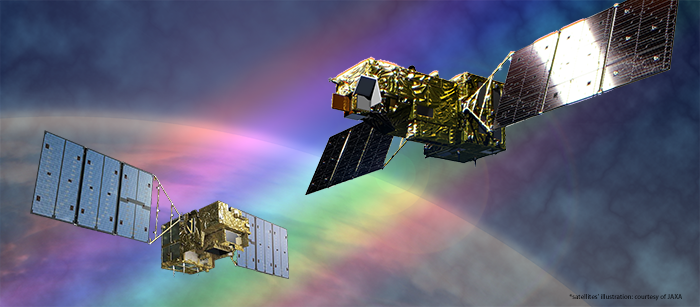
GOSAT Series
Research Announcements
- Aug. 11, 2020The selection result of the second Research Announcement on Greenhouse gases Observing SATellite Series (the 2nd GOSAT RA)NEW
- Oct. 21, 2019The Second Research Announcement on Greenhouse gases Observing Satellite Series (2nd GOSAT RA) issued. The proposal submission deadline is on Friday, January 3, 2020.
The Greenhouse gases Observing SATellite (GOSAT) has been observing global atmospheric greenhouse gases steadily even today, in the tenth year since its launch in January 2009. The successor, GOSAT-2, was launched on October 29, 2018 and has started its nominal operation in February 2019. Given this situation, the Second Research Announcement on Greenhouse gases Observing Satellite Series (2nd GOSAT RA) has issued to solicit research proposals utilizing both GOSAT and GOSAT-2 data.
If you plan to conduct research using GOSAT and GOSAT-2 data, please read the following documents carefully, and send your research proposal and application documents to the GOSAT RA Secretariat by the due date. We are really looking forward to receiving your original proposals.
- Schedules for the 2nd GOSAT RA
- Issue of Research Announcement: Monday, October 21, 2019
- Proposal Submission Deadline: Friday, January 3, 2020
- Notification of Selection Results: Friday, March 6, 2020 or later
- The Second Research Announcement on Greenhouse Gases Observing Satellite Series (pdf 193KB)
- Appendix A GOSAT/GOSAT-2 Data Policy (pdf 439KB)
- Appendix B General Terms and Conditions for the Joint Research Agreement in accordance with the Research Announcement on Greenhouse Gases Observing Satellite Series (pdf 179KB)
- Appendix C-1 Application form for the Joint Research Agreement in accordance with the Research Announcement on Greenhouse Gases Observing Satellite Series(docx 21KB)
- Appendix C-2 Guidelines for research proposal and related forms (doc 83KB)
We appreciate all the researchers who submitted their research proposals in response to the second Research Announcement on Greenhouse gases Observing SATellite Series (the 2nd GOSAT RA). All proposals were evaluated by the GOSAT RA Selection and Evaluation Committee based on reviews by professionals, and we would like to inform you that the Japan Aerospace Exploration Agency (JAXA), the National Institute for Environmental Studies (NIES), and the Ministry of the Environment of Japan (MOE) have jointly decided to adopt eight research proposals listed below to carry out joint research.
| Principle Investigator1) | Research Organization | Research Theme |
|---|---|---|
| Calibration | ||
| KOUYAMA Toru | National Institute of Advanced Industrial Science and Technology (AIST)(Japan) | Advancing sensor calibration of CAI-2 with a new Lunar calibration approach |
| Data processing algorithms | ||
| Zhao-Cheng Zeng | University of California, Los Angeles (USA) | Profiling aerosols using oxygen A-band measurements from GOSAT/GOSAT-2 |
| Jochen Landgraf | SRON Netherlands Institute for Space Research (The Netherlands) | Application of the RemoTeC retrieval algorithm to GOSAT-FTS2 measurements and exploring the value of the 2.3μm band to CH4 retrievals. |
| Carbon balance estimation, atmospheric transport models | ||
| Avelino F. Arellano, Jr. | University of Arizona (USA) | Inverse modeling of anthropogenic carbon sources using GOSAT CO, CO2 and CH4 |
| Peter Rayner | School of Earth Sciences, the University of Melbourne (Australia) | Methane budgets for Australia―Mapping Australia's methane emissions using GOSAT and GOSAT-2 Data |
| Validation | ||
| TANIMOTO Hiroshi | Center for Global Environmental Research, National Institute for Environmental Studies (Japan) | Combined cargo-ship and passenger aircraft observations-based validation of GOSAT-2 GHG observations over the open oceans |
| KOBAYASHI Hiroshi | University of Yamanashi (Japan) | Development and validation of data processing algorithms for the whole-sky radiometer and validation of GOSAT series cloud and atmospheric aerosol products |
| Data application | ||
| Sujong Jeong | Graduate School of Environmental Studies, Seoul National University (Korea) | Satellite validation and monitoring of combustion efficiency in Seoul using GOSAT2 and ground observations |
1) For Japanese nationals who belongs to Japanese organization, each surname is written in all uppercase letters, followed by the given name. Other names are written as written on each application.
Greenhouse Gases Observing Satellite Series Research Announcement Secretariat, Satellite Observation Center,
National Institute for Environmental Studies
16-2 Onogawa, Tsukuba, Ibaraki 305-8506, Japan
Tel: +81-29-850-2966 (10 a.m. - 5 p.m.)
Fax: +81-29-850-2219
E-mail: gosat-prj1[at]nies.go.jp




